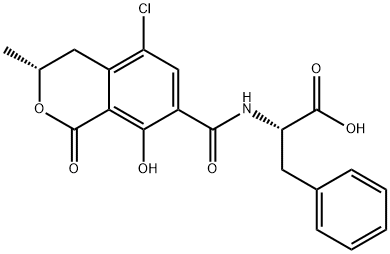
Охрадоксин A
- английское имяOCHRATOXIN A
- CAS №303-47-9
- CBNumberCB5325836
- ФормулаC20H18ClNO6
- мольный вес403.81
- EINECS206-143-7
- номер MDLMFCD00078079
- файл Mol303-47-9.mol
| Температура плавления | 169°C |
| альфа | D -118° (c = 1.1 in CHCl3) |
| Температура кипения | 632.4±55.0 °C(Predicted) |
| плотность | 1.2459 (rough estimate) |
| показатель преломления | 1.6000 (estimate) |
| Fp | 2 °C |
| температура хранения | 2-8°C |
| растворимость | ethanol: soluble |
| форма | powder |
| пка | 3.29±0.10(Predicted) |
| цвет | White to off-white |
| Биологические источники | Aspergillus ochraceus |
| Мерк | 13,6772 |
| БРН | 8169012 |
| Словарь онкологических терминов NCI | L |
| FDA UNII | 1779SX6LUY |
| МАИР | 2B (Vol. Sup 7, 56) 1993 |
| Предложение 65 Список | Ochratoxin A |
| Система регистрации веществ EPA | Ochratoxin A (303-47-9) |
| UNSPSC Code | 85151701 |
| NACRES | NA.77 |
| Коды опасности | T+,T,Xn,F | |||||||||
| Заявления о рисках | 45-46-61-26/27/28-36-20/21/22-11-40-28-39/23/24/25-23/24/25-65-48/23/24/25-36/38 | |||||||||
| Заявления о безопасности | 53-22-36/37/39-45-36-26-16-36/37-28-62 | |||||||||
| РИДАДР | UN 3462 6.1/PG 2 | |||||||||
| WGK Германия | 3 | |||||||||
| RTECS | AY4375000 | |||||||||
| F | 10 | |||||||||
| Класс опасности | 6.1(a) | |||||||||
| Группа упаковки | I | |||||||||
| кода HS | 29322985 | |||||||||
| Банк данных об опасных веществах | 303-47-9(Hazardous Substances Data) | |||||||||
| Токсичность | LD50 orally in rats: 20-22 mg/kg (Purchase, Theron) | |||||||||
| NFPA 704: |
|
рисовальное письмо(GHS)
-
рисовальное письмо(GHS)


-
сигнальный язык
опасность
-
вредная бумага
H350:Может вызывать раковые заболевания.
H300+H310+H330:Смертельно при проглатывании, при контакте с кожей или при вдыхании.
H360:Может отрицательно повлиять на способность к деторождению или на неродившегося ребенка.
-
оператор предупредительных мер
P202:Перед использованием ознакомиться с инструкциями по технике безопасности.
P260:Не вдыхать газ/ пары/ пыль/ аэрозоли/ дым/ туман.
P264:После работы тщательно вымыть кожу.
P280:Использовать перчатки/ средства защиты глаз/ лица.
P302+P352+P310:ПРИ ПОПАДАНИИ НА КОЖУ: Промыть большим количеством воды. Немедленно обратиться за медицинской помощью.
P304+P340+P310:ПРИ ВДЫХАНИИ: Свежий воздух, покой. Немедленно обратиться за медицинской помощью.
Охрадоксин A химические свойства, назначение, производство
Химические свойства
white to off-white crystalline powderИспользование
Ochratoxin A is a chlorinated benzopyran coupled to phenylalanine, produced by several Aspergillus and Penicillium sp. associated with food spoilage. Ochratoxins are widely distributed in the environment and are known to be nephrotoxic, teratogenic and possibly carcinogenic. Ochratoxin A may act by inducing DNA strand breaks, sister chromatid exchanges, DNA adduct formation, or reactive oxygen but the mechanism of action as a toxin is not yet resolved. At the molecular level, ochratoxin A specifically inhibits NK cell activity, increases growth of transplantable tumour cells in mice, increases apoptosis, activates c-Jun N terminal kinase in human kidney epithelial cells, and blocks metaphase/anaphase transition. It also inhibits plasminogen activator inhibitor-2 production by human blood mononuclear cells.Определение
ChEBI: A phenylalanine derivative resulting from the formal condensation of the amino group of L-phenylalanine with the carboxy group of (3R)-5-chloro-8-hydroxy-3-methyl-1-oxo-3,4-dihydro-1H-2-benzopyran-7-carb xylic acid. It is among the most widely occurring food-contaminating mycotoxins, produced by Aspergillus ochraceus, Aspergillus carbonarius and Penicillium verrucosum.Общее описание
White crystalline powder.Реакции воздуха и воды
Insoluble in water.Профиль реактивности
OCHRATOXIN A is incompatible with strong oxidizing agents, strong acids and strong bases. . OCHRATOXIN A is a carboxylic acid derivative. Carboxylic acids donate hydrogen ions if a base is present to accept them. They react in this way with all bases, both organic (for example, the amines) and inorganic. Their reactions with bases, called "neutralizations", are accompanied by the evolution of substantial amounts of heat. Neutralization between an acid and a base produces water plus a salt.Опасность
Hepatotoxic, nephrotoxic, extremely toxic; possible carcinogen.Пожароопасность
Flash point data for OCHRATOXIN A are not available; however, OCHRATOXIN A is probably combustible.Биологическая активность
Mycotoxin that increases activity of the endoplasmic reticulum ATP-dependent calcium pump. Induces JNK activation and apoptosis in MDCK-C7 cells at nanomolar concentrations. Stimulates lipid peroxidation.Профиль безопасности
Confirmed carcinogen with carcinogenic and neoplastigenic data. Poison by ingestion, intraperitoneal, intravenous, and subcutaneous routes. Experimental teratogenic and reproductive effects. Mutation data reported. When heated to decomposition it emits very toxic fumes of Cland NOx.Возможный контакт
Ochratoxin A, a carboxylic acid derivative and a naturally occurring toxic mold (strain of Aspergillus ochraceus), occasionally in storage grains such as wheat and on field crops such as corn and oilseed (i.e., cottonseed), in ancient tombs, and decayed vegetation. Used as a laboratory chemical for research. Not currently produced in the United States.Канцерогенность
Ochratoxin A is reasonably anticipated to be a human carcinogen based on sufficient evidence of carcinogenicity from studies in experimental animals.Перевозки
UN2811 Toxic solids, organic, n.o.s., Hazard Class: 6.1; Labels: 6.1-Poisonous materials, Technical Name Required. UN3462 Toxins, extracted from living sources, solid, n.o.s., Hazard Class: 6.1; Labels: 6.1-Poisonous materials, Technical Name Required.Несовместимости
Ochratoxin A is Incompatible with oxidizers (chlorates, nitrates, peroxides, permanganates, perchlorates, chlorine, bromine, fluorine, etc.); contact may cause fire. Keep away from alkaline materials, strong bases, strong acids, oxoacids, and epoxides. Compounds of the carboxyl group R.COOH Compounds of the carboxyl group react with all bases, both inorganic and organic (i.e.,amines) releasing substantial heat, water, and a salt that may be harmful. Incompatible with arsenic compounds (releases hydrogen cyanide gas), diazo compounds, dithiocarbamates, isocyanates, mercaptans, nitrides, and sulfides (releasing heat, toxic, and possibly flammable gases), thiosulfates and dithionites (releasing hydrogen sulfate and oxides of sulfur).Утилизация отходов
Consult with environmental regulatory agencies for guidance on acceptable disposal practices. Generators of waste containing this contaminant (≥100 kg/mo) must conform with EPA regulations governing storage, transportation, treatment, and waste disposal. Under 40 CFR 261.5 small quantity generators of this waste may qualify for partial exclusion from hazardous waste regulations.Охрадоксин A запасные части и сырье
запасной предмет